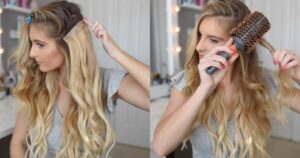Hair coloring involves the use of chemicals to alter the natural pigments of your hair, creating a new shade or covering gray strands. The two main types of hair dyes are permanent and semi-permanent. Permanent dyes penetrate the hair shaft, while semi-permanent ones sit on the surface. Both alter the structure of the hair, making it crucial to follow appropriate care practices.
Chlorine, commonly used in swimming pools to disinfect water, can have varying effects on hair, especially color-treated strands. It’s a powerful chemical that can strip natural oils from hair and affect the color molecules in dyed hair.
Imagine the sun shining, the pool beckoning, and you, with your newly colored hair, contemplating a refreshing dip. The interaction between chlorine and hair dye is akin to a delicate dance between science and aesthetics. Let’s unravel the intricacies and find out if your post-coloring water adventures are a friend or foe to your vibrant locks.
The Role of Chlorine in Pool Hygiene and Hair Color
Chlorine is added to swimming pools to kill bacteria and other pathogens. It serves a crucial role in maintaining pool hygiene, and its impact on hair can be quite significant. When you color your hair, the cuticle layer is opened to allow the color molecules to penetrate
Chlorine’s c and Health
Chlorine, with its harsh properties, can disturb this layer, leading to color fading. The natural oils that protect and nourish your hair. It tends to strip away leaving it dry and more susceptible to damage. The colored hair makes it more prone to absorbing chlorine, intensifying the risk of discoloration.
Understanding the Chemistry:
To understand the effects of chlorine on colored hair, it’s essential to delve into the chemistry. Chlorine interacts with the proteins in your hair, particularly keratin. The cuticle, acting as a protective barrier, shields the inner layers of the hair shaft.
| Aspect | Effect of Chlorine |
| Cuticle Disruption | When chlorine disrupts this cuticle, it not only compromises the integrity of the hair but also weakens the bonds that hold the color molecules. |
| Color Leaching | This chemical reaction can result in the leaching of color, leaving your once vibrant strands looking dull and lackluster. |
In the table above, you can see the two main aspects of the chemistry behind the effects of chlorine on colored hair and how chlorine affects each aspect.
Tips for Pre-Swim Protection:
Now that we understand the potential risks, it’s time to explore preventive measures for those who can’t resist the allure of a pool or the ocean. Before taking the plunge, consider applying a leave-in conditioner or hair oil to create a protective barrier.

After coloring my hair, it’s important to take extra precautions to protect your new shade. This extra layer can help shield your hair from the harsh effects of chlorine. Additionally, when you plan to swim after coloring my hair wearing a swim cap is a simple yet effective way to keep your color-treated hair safeguarded from chlorine exposure. Remember, prevention is key when it comes to maintaining the vibrancy of your newly colored locks
Post-Swim Care for Colored Hair:
While preventative measures are essential, post-swim care is equally crucial. After your aquatic escapade, rinse your hair thoroughly with fresh water to remove any lingering chlorine. Follow up with a moisturizing shampoo and conditioner specifically designed for color-treated hair.
These products help replenish lost moisture and nutrients, ensuring your hair remains healthy and vibrant. Consider incorporating a deep conditioning treatment into your routine to provide an extra boost of hydration, revitalizing your color-treated strands.
The Role of Water Temperature:
Beyond chlorine, the temperature of the water can also influence the health of your color-treated hair. Hot water opens the hair cuticle, making it more susceptible to the effects of chlorine. Opt for lukewarm or cool water when rinsing your hair post-swim to help seal the cuticle and minimize color loss. This simple adjustment can go a long way in preserving the brilliance of your hair color.
FAQS
Can I Swim Immediately After Coloring My Hair?
After coloring your hair, it’s generally recommended to wait at least 72 hours before exposing your hair to chlorine or saltwater. This allows the hair cuticle to close and the color to set. Swimming too soon after coloring may increase the risk of color fading or alteration due to the chemicals in the pool.
How Does Chlorine Affect Colored Hair?
Chlorine can have adverse effects on colored hair by stripping away natural oils and disrupting the hair cuticle. This can result in increased porosity, making colored hair more susceptible to color fading. Understanding the chemical interaction between chlorine and hair helps in adopting preventive measures and proper post-swim care to minimize these effects.
Are Swim Caps Effective in Protecting Colored Hair?
Yes, swim caps are effective in creating a barrier between your colored hair and chlorinated water. Wearing a swim cap can significantly reduce the exposure of your hair to chlorine, helping to preserve the vibrancy of your hair color. It’s a simple yet practical solution for those who want to enjoy swimming without compromising their hair color.
Do Hot Water and Chlorine Have a Cumulative Effect on Hair Color?
Yes, hot water can open the hair cuticle, making it more susceptible to the effects of chlorine. The combination of hot water and chlorine can contribute to color fading. Rinsing your hair with lukewarm or cool water after swimming helps to seal the cuticle and minimize color loss, ensuring your hair remains vibrant.
What Pre-Swim Measures Can I Take to Protect My Colored Hair?
Before taking a dip, consider applying a leave-in conditioner or hair oil to create a protective barrier on your hair. Additionally, using a swim cap is an excellent preventive measure. These steps can help shield your colored hair from the harsh effects of chlorine, reducing the risk of color fading and damage.
Are There Special Shampoos and Conditioners for Colored Hair After Swimming?
Yes, using shampoos and conditioners specifically designed for color-treated hair is crucial after swimming. These products are formulated to gently cleanse and moisturize colored hair, helping to restore any lost moisture and nutrients. Regular use of such products contributes to maintaining the vibrancy and health of your colored locks.
Conclusion:
In the tapestry of hair care and recreation, the question of swimming in chlorine after coloring your hair weaves a delicate narrative. Balancing the desire for a dip in the pool with the commitment to vibrant hair color requires a nuanced understanding of the interplay between chemicals and aesthetics.
In essence, the keyword, “Can you swim in chlorine after coloring your hair,” encapsulates not just a query but a quest for a harmonious coexistence of personal style and leisure. The key lies not in avoidance but in informed management. So, dive into the turquoise waters, let the chlorine-infused waves caress you, and emerge with hair that remains a testament to your style and the resilience of thoughtful care.











